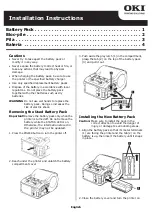
English –
119
2
Manual drive mode logging in CST can indicate
breaks and short circuits. A short circuit is the
when the drive stage If the drive circuit inside CCU
attempts to drive a higher current than it can han-
dle (1 Ampere), it will turn off its output at the same
time as it pulls its Fault output to "Low". When the
circuit closes its output, Out 2 status will change to
"High". The following test results are then obtained
(same indication for short circuit and break).
Main relay circuit on = Green
Main relay circuit status = Red
Main relay circuit fault status = Red
If this result is obtained during the test, the reason
for excessive current going to CCU or that it is a
break must be investigated. This can be due to the
relay coil in the main relay having burned, caus-
ing a short circuit in the coil so that the current
is not limited. It can also be due to a defective
freewheeling diode over the coil, causing current
to flow back. It could also be due to conduction
somewhere so that CCU connector C:7 is not
receiving a current-limited supply. The relay will not
be energized during the test if there is a break but
if the output is short circuited to GND, the relay will
be energized as long as the key is in the ON posi-
tion. A break can be due to cable fault or that the
relay coil has a break or that the drive motor is not
sending a drive voltage to the relay.
Main relay
If the current is too high (short circuit)
during the test, check these components
12.7 Switches
Switches
Lift switch
Seat switch
Cutting deck status
Up
Driver not seated
Not locked
This box shows the state of the Lift switch, Seat
switch and Cutting deck status. The switch indicat-
ed that the cutting deck is mounted and locked.
That the lift switch is in order can be seen by
lowering the cutting deck, this should activate the
input. That the cutting deck fails to start despite
receiving this signal may be due to the motor
controls on the cutting deck not receiving the ac-
tivating signal. The function is such that when the
cutting deck is lowered, CCU receives an input sig-
nal from one of the switches (lift switch), these are
mounted so they can detect that the lifting lever for
the cutting deck has left its raised position.
When CCU receives this signal (lift switch), it
sends an activating signal to its output to start the
cutting deck, this output cannot be activated by
CCU. If the safety switch is not activated (CCU
receives signal from seat switch) and that the cut-
ting deck is mounted (cutting deck status). These
two signals are hardwired so they do not go via the
software to ensure stable function (start of cutting
deck). If these two signals are OK, the output will
be connected and CCU sends a signal (battery
voltage level of signal) to start the cutting deck, this
signal goes via the other microswitch mounted to
detect if the cutting deck is lowered. The cutting
deck should now start if this microswitch is in or-
der. If the cutting deck fails to start, first check that
all three signals from Lift Switch, Seat Switch and
Cutting Deck Status.
If these signals are obtained and the cutting deck
fails to start, a multimeter in volt mode must be
used to measure the other microswitch that is
mounted to detect whether the lifting lever is
raised. A brown lead runs to the switch that comes
from the CCU output for starting the cutting deck
and out from the switch come two yellow leads that
run down to the cutting deck and are connected to
the cutting motor controls via two four-pole con-
nectors.
CST-drive mode logging
Summary of Contents for 967187001
Page 1: ...Workshop manual Rider Battery English ...
Page 2: ......
Page 28: ...English 28 6 5 Exploded View Drawing Cutting Deck Basic dismantle assembly ...
Page 62: ...Repair Work English 62 4 Assemble the new baffle plate 5 Refit the spring and contact ...
Page 143: ......
Page 144: ...2015W44 115 75 74 26 ...
















































